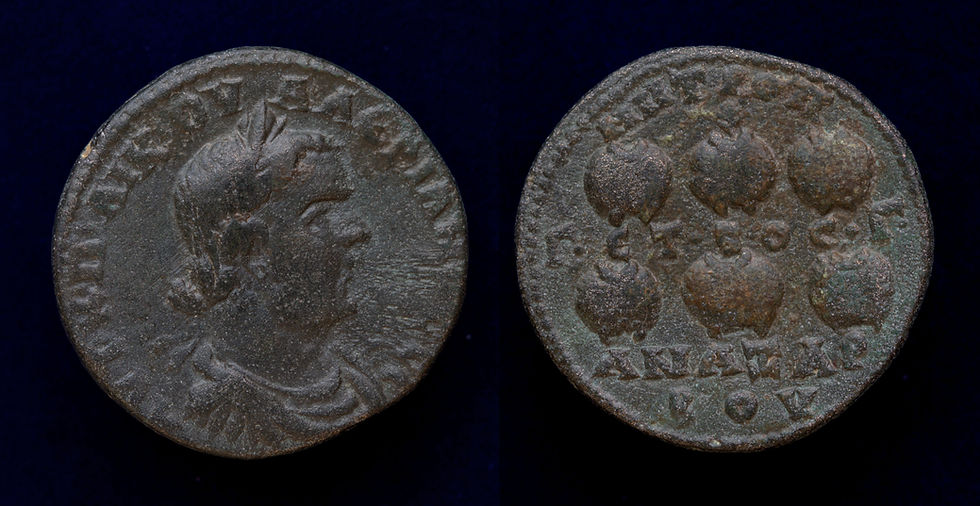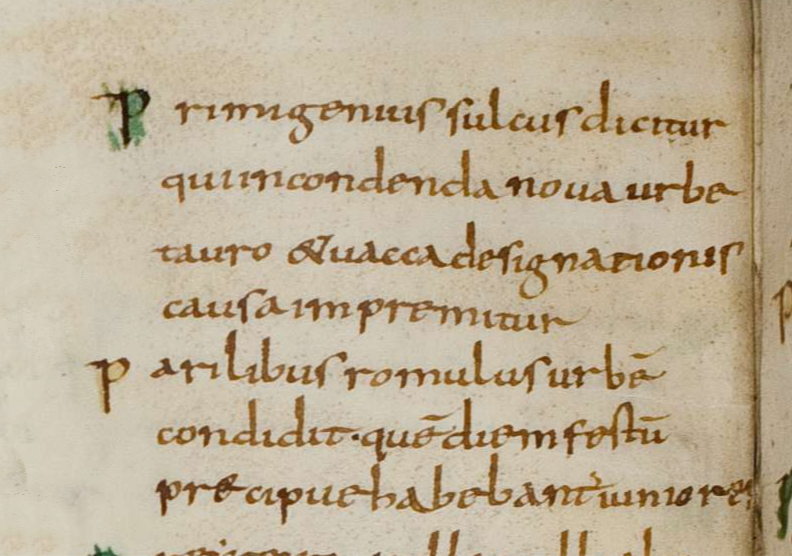First, Greatest and Most Beautiful
- sulla80

- Oct 17, 2021
- 3 min read
Updated: Oct 8, 2023
"The site of the Cilician city known during the period of the Roman Empire as Caesarea, Caesarea by Anazarbus, or Anazarbus , is some 28 km. south of Kozan in the Turkish province of Seyhan. The place still retains its name as Anavarza, a hamlet built just outside the walls of the ancient city." -Michael Gough, Anazarbus, 1952

Ruins of the West gate of Anazarbus, Cilicia, with Anvarza Castle in the distance. Image by Mustafa Tor at English Wikipedia, CC BY-SA 3.0, via Wikimedia Commons
This Cilician coin is from the reign of Roman emperor Valerian. Towns in Cilicia seemed to enjoy sparring with one another for supremacy. There is a variant of this coin with a different reverse legend "ANAZAPBOV MHTPOΠOΛEOC / AMK" - The Metropolis of Anazarbus declaring itself "A M K" or "#1 greatest and most beautiful" (A - Greek #1, M - μεγίστης, K - καλλίστης).

Cilicia, Anazarbus, Valerian I, AD 253-260, Æ Hexassarion (27mm, 16.32 g, 6h), dated CY 272 (AD 253/4)
Obv: AVT K Π ΛIK OVAΛEPIANOC CE, laureate, draped, and cuirassed bust right
Rev: MHTPOΠ above, ET BOC between Γ- Γ between and ANAZAP/BOV below, six prize crowns in two rows of three
Ref: Ziegler 836.1 (dies Vs1/Rs4)
In his book on the coins of this region Ziegler (p.124) describes Γ- Γ as being two greek numbers (3) - which mean "head of 3 provinces", "3 times neokoros ". BOC is a civic year date (2 (B) + 70 (O) + 200 (C)) which maps to AD 253/4. The "prize crowns" on the reverse were prizes from agonistic festivals where cities competed against each other.
Honors bestowed (and taken away) by the emperor
Neocorate (neokoros) was the right to build a temple for the cult of the Roman emperor. Being neokoros brought status to a city within its region and recognition for having a relationship with Rome. The word "neokoroi" is literally νεώς 'temple' + κορέω 'to sweep'. A temple would have value to the economy with visitors bringing money to the city. Cities competed for these honors and other titles, and celebrated them (boasted) on their coins.
What the emperor and Roman Senate granted, they could take away. Nicaea, in Bythinia, who had taken the losing side, supporting Pescennius Niger, at the beginning of Septimius Severus' run for emperor in the year of five emperors, was penalized for not supporting him with the removal of their neokoroi. Septimius Severus also rewarded Nicaea’s rival, Nicomedia, with a second neokoria for their support.
All of Cilicia was on the verge of a big change as these coins were issued. The accomplishments of Sasanian King, Shapur I, in ~260AD are described as follows:
"the land of Syria, the land of Cilicia, and the land of Cappadocia were burned, laid waste, and plundered"
-Res Gestae Divi Saporis, “The Things Accomplished by the Divine Shapur.”, translation by Jake Nabel, 23-25
The cities of Corycus, Anazarbus and about 34 others are explicitly mentioned as "taken from the land of the Romans" along with the surrounding regions. More on Valerian's capture and the challenge he left to his son Gallienus in this related post: Gallienus and Usurpers in AD 260.
Shapur was pushed back by Macrianus (who would later put forward his two sons and emperors. Shapur's push into Cilicia wasn't complete and stopped short of the western third. This "victory" coin from Gallienus issued in Cilicia.

Cilicia, Seleucia ad Calycadnus, Gallienus, 253-268, Tetrassarion, AE 28mm, 11.86g, 7h)
Obv: AY K ΠΟ ΛIKIN ΓAΛΛIHNON, radiate and cuirassed bust of Gallienus to right
Rev: CЄΛЄYKЄΩΝ TΩN ΠΡ KAΛYΚAΔNΩN, Nike standing front, head to left, holding wreath in her right hand and palm frond over her left shoulder
Ref: SNG Levante 787 (double strike on reverse)
Google maps shows the distance (~250 km) from Seleucia ad Calycadnus (modern Silifke, Türkiye) to Anazarbus.
References
Gough, M. (1952). Anazarbus. Anatolian Studies, 2, 85–150.
Ziegler, R. "Kaiser, Heer und Städtisches Geld: Untersuchungen zur Münzprägung von Anazarbos und Anderer Ostkilikischer Städte". (Vienna, 1993).



Sulla, Another interesting article on a Roman colony not often discussed 😉. The competitive nature of the cities in Cilicia is interesting too 😂. I've read that Roman soldiers were encouraged to retire in the cities of Cilicia, so maybe that's what sparked the competitive nature of these cities & the boastful inscriptions on the coinage. Pictured below is my only coin from Anazarbus.